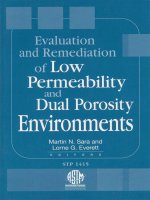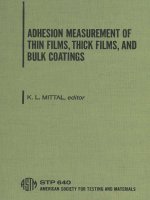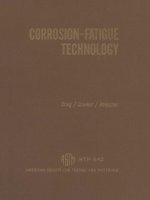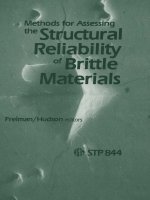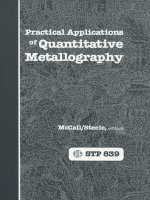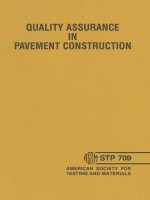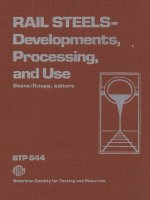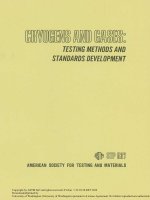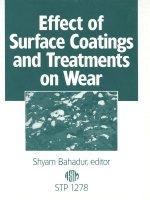Astm stp 1416 2002
Bạn đang xem bản rút gọn của tài liệu. Xem và tải ngay bản đầy đủ của tài liệu tại đây (6.01 MB, 278 trang )
STP 1416
Composite Materials: Testing,
Design, and Acceptance Criteria
A. Zureick and A. T. Nettles, editors
ASTM Stock Number: STPI416
ASTM International
100 Barr Harbor Drive
PO Box C700
West Conshohocken, PA 19428-2959
INTERNATIONAL
Printed in the U.S.A.
Library of Congress Cataloging-in-Publication Data
Composite materials : testing, design, and acceptance criteria / A. Zureick and A. T.
Nettles, editors.
p. cm.
"ASTM stock number: STP1416."
Includes bibliographical references and index.
ISBN 0-8031-2893-2
1. Composite materials--Congresses. I. Zureick, AbduI-Hamid. I1. Nettles, A. T. (Alan T.)
TA418.9.C6 C5545 2002
620.1'18~dc21
2002066562
Copyright 9 2002 AMERICAN SOCIETY FOR TESTING AND MATERIALS INTERNATIONAL, West
Conshohocken, PA. All rights reserved. This material may not be reproduced or copied, in whole or
in part, in any printed, mechanical, electronic, film, or other distribution and storage media, without
the written consent of the publisher.
Photocopy Rights
Authorization to photocopy items for internal, personal, or educational classroom use, or
the internal, personal, or educational classroom use of specific clients, is granted by ASTM
International provided that the appropriate fee is paid to the Copyright Clearance Center, 222
Rosewood Drive, Danvers, MA 01923; Tel: 978-750-8400; online: http:llwww.copyright.com/.
Peer Review Policy
Each paper published in this volume was evaluated by two peer reviewers and at least one editor. The authors addressed all of the reviewers' comments to the satisfaction of both the technical
editor(s) and the ASTM Committee on Publications.
To make technical information available as quickly as possible, the peer-reviewed papers in this
publication were prepared "camera-ready" as submitted by the authors.
The quality of the papers in this publication reflects not only the obvious efforts of the authors
and the technical editor(s), but also the work of the peer reviewers. In keeping with long-standing
publication practices, ASTM International maintains the anonymity of the peer reviewers. The ASTM
Committee on Publications acknowledges with appreciation their dedication and contribution of
time and effort on behalf of ASTM International.
Printed in Chelsea, MI
June 2002
Foreword
This publication, Conq~osite Materials: Testing, Design, and Acceptance Criteria, contains
papers presented at the symposium of the same name held in Phoenix, Arizona, on 26-27
March, 2001. The symposium was sponsored by ASTM International Committee D30 on
Composite Materials. The symposium co-chairmen were A.-H. Zureick, Georgia Institute of
Technology, Atlanta, Georgia and A. T. Nettles, NASA Marshall Space Flight Center, Huntsville, Alabama.
Contents
Tabbed Versus U n t a b b e d Fiber-Reinforced Composite Compression
S p e c i m e n s ~ o . F. ADAMS
Multi-Axial Composite Tube Test M e t h o d ~ D . COHEN
3
17
Finite Element Analysis of Unidirectional Composite Compression Test
Specimens: A P a r a m e t r i c Study--P. J. JOYCE, M. G. VIOLgTTE, AND
30
T. J. M O O N
S t r u c t u r a l Integrity Assessment of Composite Pressure Test Box Through Full
Scale Test--B. K. PARIDA, P. K. DASH, S. A. HAKEEM, AND K. CHELLADURAI
69
Qualification Using a Nested Experimental Design--D. RUFFNER AND P. JOUIN
85
The Development and Use of a C o m m o n Database for Composite M a t e r i a l s m
P. S H Y P R Y K E V I C H , J. S. T O M B L I N , A N D M. G. V A N G E L
A C o m p a r i s o n of Quasi-Static I n d e n t a t i o n Testing to Low Velocity I m p a c t
Testing--A. T. NETTLES A N D M. J. D O U G L A S
99
116
Detection a n d Characterization of Imperfections in Composite Pressure
L. W A L K E R , S. S. RUSSELL, A N D M, D. L A N S I N G
131
Damage Resistance a n d Damage Tolerance of P u l t r u d e d Composite Sheet
Materials--R. PRABHAKARAN,M. SAHA, M. DOUGLAS, AND A. T. NETTLES
139
Vessels--J.
Mechanical Degradation of Continuous Glass Fibre-Reinforced Thermoplastics
U n d e r Static a n d Cyclic Loading: A Prepreg L a m i n a t e - - T e c h n i c a l Textile
C o m p a r i s o n - - J . F. NEFT, K. S C H U L T E , AND P. SCHWARZER
156
Philosophies for Assessing Durability of Commercial a n d I n f r a s t r u c t u r e
Composite Systemsms. w. CASE, K. L. REIFSNIDER, A N D J. J. LESKO
173
C o m p u t a t i o n a l Prediction of Yarn Structure of 3D-Braided C o m p o s i t e s - G. TERPANT, P. KRISHNASWAMI,AND Y. WANG
188
Principles for Recovering Micro-Stress in Multi-Level Analysis--Y. WANG,
C. S U N , X. SUN, A N D N. J. P A G A N O
200
Measurement of CTE at Reduced Temperature for Stressed Specimens-H. Z H U , W . - Y . LI, A. A. T S E N G , A N D P. P H E L O N
212
The Effect of Moisture, Matrix and Ply Orientation on Delamination
Resistance, Failure Criteria and Fracture Morphology in C F R P - E. S. G R E E N H A L G H A N D S. SINGH
221
Interlaminar Crack Propagation in CFRP: Effects of Temperature and
Loading Conditions on Fracture Morphology and Toughness--a. SJOGREN.
L. E. ASP, E. S. G R E E N H A L G H , A N D M. J. HILEY
235
Buckling and Fracture Behavior of Tapered Composite Panels Containing Ply
Drops--a. K. PARIDA,K. VIJAYARAJU,AND P. D. MANGALGIRI
253
Author Index
271
Subject Index
273
Donald F. Adams /
Tabbed Versus Untabbed Fiber-Reinforced Composite Compression Specimens
Reference: Adams, D.F., "Tabbed Versus Untabbed Fiber-Reinforced Composite
Compression Specimens," Composite Materials: Testing, l)esign, and Acceptance
('riteria, AS'IM SIP 1416, A. Zureick and A.T. Nettles, Eds., American Society for
Testing and Materials International, West Conshohocken, PA, 2002.
Abstract: The development of suitable specimen configurations and loading methods
for the compression testing of high strength composite materials has received
considerable attention during the past decade, and especially during the past five years.
Both experimental and analytical investigations of very. specific aspects of specimen and
test fixture configurations have been performed. Many seemingly conflicting results
have been presented, leading to considerable confusion within the composite materials
testing community. However, a definite conclusion appears to now be emerging, viz., the
use of tabs on compression test specimens has a detrimental influence on measured
strength. This has been qualitatively suspected for some time since analytical studies and
detailed finite element analyses consistently predict induced stress concentrations at the
tab ends of the specimen gage section. Numerous approaches have been followed to
minimize these stress concentrations, of course including the total elimination of tabs.
Key analytical and experimental results, taken from the extensive published literature as
well as from the author's own recent work, are presented and compared, to demonstrate
the consistent trends that actually do exist in the seemingly scattered and confusing
published literature. Finally, options currently available for the successful compression
testing of high strength composite materials are presented.
Keywords:
compression testing, compressive strength, specimen configurations,
specimen tabs, loading methods, analysis, testing
The Purpose of Specimen Tabs
There are two fundamental ways of applying a compressive force to laboratory, test
specimens, viz., end loading or shear loading. As implied, end loading is the direct
application of opposing compressive forces at the ends &the specimen. Shear loading is
the application of opposing shear force distributions at each end of the specimen; these
shear forces being distributed over some prescribed length of the specimen faces. These
shear forces induce a compressive force in the gage section of the specimen, i.e.,
1 President, Wyoming Test Fixtures, Inc., 421 S. 19th Street, Laramie, WY 82070, and
Professor Emeritus, Mechanical Engineering Department, University of Wyoming,
Laramie, WY 82071.
Copyright9
by ASTMInternational
www.astm.org
4
COMPOSITEMATERIALS
the central region of the specimen between the end regions where the shear forces are
applied.
High strength composite materials, e.g., those exhibiting axial compressive strengths
above about 1 GPa (150 ksi), are particularly diffficult to test using either of these load
introduction methods. Such materials tend also to be relatively stiff, and highly
orthotropic. In particular, the transverse tensile and compressive strengths and the
longitudinal shear strength are low relative to the axial compressive (and tensile) strength.
A unidirectionally reinforced composite material is an example of such a composite.
End loading typically results in crushing of the specimen ends, due to the difficulty of
introducing the compressive force uniformly over the end of the specimen (being
compounded by the high stiffness of the material). Any loading nonuniformity creates
local stress concentrations, which are not readily redistributed because of the high
orthotropy of the material (in particular here a relatively low shear strength), leading to
premature failure (brooming and crushing) at the specimen ends. The most common
method of reducing the average stress at the specimen ends and thus making the stress
concentrations less critical is to bond tabs (doublers) adhesively on opposing faces at each
end of the specimen, as shown in Figure 1. These tabs increase the contact area over
which the end loading is applied. Thus, when local stress concentrations do occur at the
ends, the maximum stress will hopefully still be less than that in the gage section of the
specimen, resulting in gage section failures as desired. Of course, any force applied at the
end of a tab must be transferred via shear into the test specimen itself over the length of
the tab. Thus, a tabbed, end-loaded specimen is effectively being subjected to a
combination of end and shear loading.
f
I
tab
S_._.specimen
f
i
gage length
Figure 1 - Typical tapered tab compression test specimen.
In the case of pure shear loading, all of the applied force is introduced via a shear
transfer mechanism. Although end crushing is nonexistent, local stress concentrations are
still a problem, occurring along the specimen surfaces where the shear forces are acting.
These shear forces are applied using grips of some type, which clamp the specimen
surfaces at each end and transfer force by friction. Smooth, fiat grip surfaces would aid,
although not guarantee, uniform shear force transfer. However, smooth grip surfaces
result in relatively low coefficients of friction, thus requiring very high clamping forces to
prevent slipping. But by definition, the transverse (here compressive) strength of the
highly orthotropic material being tested is relatively low, resulting in potential crushing of
the specimen in the gripped regions. Thus, more aggressive grip faces are usually used,
which dig into the surface of the specimen, increasing the effective coefficient of friction
and permitting the use of lower clamping forces. These aggressive grip faces would
ADAMS ON TABBED/UNTABBED FIBER-REINFORCED COMPOSITE
5
damage the surface of the test specimen, weakening the material. Thus, tabs are bonded
onto the specimen surfaces to protect them.
In summary, whether end- or shear-loaded, the test of a high compressive strength
specimen typically incorporates tabs.
The D e t r i m e n t a l C o n s e q u e n c e s o f Using Tabs
For the reasons discussed in the previous section, high compressive strength
composite material test specimens typically incorporate adhesively bonded tabs. Detailed
stress analyses, particularly finite element analyses, conducted during the past ten or more
years, have clearly shown that stress concentrations are induced in the test specimen at the
ends of the tabs adjacent to the gage length [1-14]. A typical example is shown in Figure
2. Transverse normal and longitudinal shear stress concentrations exist also. How
detrimental these stress concentrations actually are in reducing the measured compressive
strength of the material has not been clearly established. Nevertheless, extensive studies,
both analytical and experimental, have been conducted to seek ways of reducing these
stress concentrations.
1.4
i
Normalized
Axial
Compressive
Stress
1.2
/f
'
1.0
I
I' ..],
r-"1 gage section
0.8
0.6
0.4
~___~
gage section
specimen centerline
Figure 2 - Schematic of a typical axial compressive stress distribution
along the length of a tabbed specimen near its surface.
Only relatively recently have some general conclusions been generally accepted.
These will be discussed in detail later. However, in brief s ~ ,
more compliant tabs
reduce the stress concentrations. But compliant materials tend not to be as strong as stiffer
materials, compliance and strength typically being contrary properties. The tabs must be
strong enough to transfer the required shear stresses t~om the testing machine grips to the
specimen. Thus a compromise must be made. Tapering the ends of the tabs at the gage
section also reduces the induced stress concentrations. Thus the more taper the better.
However, the longer the taper, the longer the unsupported length (between the grips) of
6
COMPOSITEMATERIALS
the specimen, as shown in Figure 3, which can induce gross buckling rather than a
compressive failure. Thus, once again a compromise must be made, resulting in the stress
concentration possibly being reduced, but not eliminated.
I
I
~____~ gage length &
unsupported length
a) untapered (90 ~ tabs
f
tab
f
specimen
.I/i
i
gage length
unsupported length
b) tapered tabs
Figure 3 - Unsupportedspecimen lengths of tabbed specimens of equal gage length.
Of course, making the long gage length specimen thicker can prevent buckling.
However, the axial compressive stress through the thickness of the specimen gage section
then becomes more nonuniform, the stresses introduced at the specimen surfaces tending
to remain localized at these surfaces. For example, Figure 4 indicates that even at the
center of the gage section, i.e., at the maximum distance from the tab ends, the axial
compressive stress in a 10 mm (0.39 in.) thick specimen has still not attained a uniform
stress state, although the stress is relatively uniform for a 2 mm (0.080 in.) thick specimen.
This stress nonuniformity in a thick specimen compounds the seriousness of the stress
concentrations at the tab ends9 Thus, simply increasing the specimen thickness by adding
additional layers having the same lay-up as the original laminate is not a viable solution.
Since tabs are typically bonded to the test specimen, optimum adhesive material
properties and bond line thicknesses have been studied. Just as for the tab material itself,
a more compliant adhesive is better. Correspondingly, a thicker bond line is better, being
better able to blunt the stress concentration induced by the tab. However, just as for the
tabs, more compliant adhesives tend to be lower in shear strength than stiff adhesives.
Also, thick bond lines tend to be weaker than thin bond lines because of the less favorable
ADAMS ON TABBED/UNTABBED FIBER-REINFORCED COMPOSITE
7
stress states that develop under shear loading. Thus, the best adhesive in terms of
reducing stress concentrations may not be strong enough to transfer the required shear
loads. Once again a compromise must be made when selecting the adhesive, and the
stress concentration is not eliminated.
5
outer surface of 10 mm thick
specimen
--
10 mm thick specimen,
shear loaded
Position
Through
Specimen
Thickness
(mm)
3
10 mm thick specimen,
end loaded
2
2 mm thick specimen,
either loadin~ method
outer surface of 2 mm thick specimen
I
0.7
0.8
mid-thickness o f specimen
0.9
1.0
1.1
Normalized Axial
Compressive Stress
Figure 4 - Axial compressive stress distribution through the thickness of a tabbed
specimen at the mid-length of the gage section for two different loading
conditions (untapered steel tabs, O.18 mm thick adhesive bond line, end loading).
The Perceived Current Status of Compression Testing
As a result of the problems summarized in the two previous sections, the compression
testing of high strength composite materials has remained a compromise. Equally
unfortunate, but understandably, different groups have selected different compromises,
with equally justifiable reasons. Thus, consensus is not likely to be achieved under the
present state of affairs.
One common, but by no means universally accepted, compromise at present is to
utilize end loading (such as the so-called Modified ASTM D 695 Compression Test
Method, which will be defined later), untapered compliant tabs (such as glass
fabric/epoxy), and a strong adhesive of medium bond line thickness (many of which are
available). Many would disagree with this compromise.
Before presenting a new appraisal of the current status of compression testing, it is
important to summarize recent key studies, both analytical and experimental, which permit
8
COMPOSITEMATERIALS
this new view. The available literature tends to be very scattered, and thus a concentrated
effort has been made to gather and digest it, as summarized in the following two sections.
Key Analyses
It will be noted that the first fourteen references here are listed chronologically.
Although a few simple, closed form analyses were attempted initially [2,3], most of the
major works have been finite element analyses [1, 4-14]. Significant interest in
characterizing the compression properties of composite materials was just emerging at the
time most of these works were being published. For example, the first ASTM test method
developed specifically for compression testing high performance composite materials,
ASTM Test Method for Compressive Properties of Polymer Matrix Composite Materials
with Unsupported Gage Section by Shear Loading (D 3410), was not issued until 1975.
At that time, it contained only the so-called Celanese compression test method, the IITRI
compression test method not being added to this standard until 1987. It was at about this
same time that Bogetti, et. al. [4] and Westberg and Abdallah [5] published their
frequently quoted f'mite element analyses.
However, one o f the first researchers to analyze in depth the problems associated with
the then accepted methods of compression testing composite materials was Tan [6-8], in
the early 1990s. This was soon followed by the extensive t'mite element analyses of Xie
and Adams [11-14]. Most of the prior analyses in the published literature, including those
by Tan, had been two-dimensional and linearly elastic in nature. Xie and Adams
developed and utilized a three-dimensional elastoplastic analysis o f the orthotropic
composite material [15,16]. Interestingly, their results showed that for the particular
problem o f analyzing a highly orthotropic (typically unidirectional) composite material
compression specimen, a three-dimensional analysis was not generally necessary. The
variations in stresses across the width of the specimen were shown to be negligible, and
the influences of material nonlinearities were relatively small. This was a significant
finding in that it gave additional confidence in all o f the prior analyses, and permitted the
use of much simpler two-dimensional linearly elastic analyses in future studies.
While there are always worthwhile additional analyses that can be performed, it
appears that the predictions of compression specimen stress states now available in the
literature, as referenced above, almost all lead to the same general conclusions, as
summarized below.
The clamping forces exerted on the specimen by the grips used to apply a shear
loading introduce a significant axial compressive stress concentration right at the
ends of the grips. This stress concentration is very localized.
When tabs are used on either shear-loaded or end-loaded compression specimens,
axial stress concentrations are also induced in the specimen at the ends o f the tabs.
These stresses are more severe for shear-loaded specimens since the tab influences
then combine with the grip influences noted above.
The tab- and grip-induced through-thickness normal stresses and longitudinal shear
stresses, while low in magnitude relative to the axial compressive stress, are not
always negligible because the corresponding strengths of the material are also
ADAMS ON TABBED/UNTABBED FIBER-REINFORCED COMPOSITE
9
relatively low. Either individually or in combination with the axial compressive
stress they can cause failure in some cases.
Away f~om the region o f local stress concentration, the axial compressive stress is
more uniform through the thickness for a thinner specimen. Since tabs transfer
forces into the specimen at the specimen surface, some axial distance is required
for the axial compressive stress to become uniform through the thickness of the
specimen, and for the transverse normal and longitudinal shear stresses to decay to
zero. That is, even though the surface stress concentration at the ends of the tabs
decays within a relatively short distance into the gage section, typically within
0.013-0.025 mm (0.050-0.100 in.), the compressive stress near the specimen
surface of a thick, shear-loaded specimen may still be significantly higher than that
in the interior, even at a considerable distance fi'om the tab end.
More compliant tabs, a more compliant adhesive, a thicker adhesive bond line, a
smaller tab taper angle, and end loading rather than shear loading all reduce the
stress concentration at the tab tip to varying degrees, but they do not eliminate it.
As discussed in the previous section, there is always a trade-offthat must be made,
so that the most favorable limits of each of these parameters individually cannot be
attained.
Key Experimental Studies
The increasing amount of experimental data that has become available during the past
several years is now strongly supporting the conclusions of the analytical studies cited
above. Publications of experimental results of particular significance include [5, 17-3 7].
Again, these references are listed in chronological order here, to emphasize the rate of
data generation in recent years. Reviews are presented in [38-41].
As one example of the progress that has been made, Smoot [17] in his M.S. thesis
work published in 1982, indicated that there was an influence of the specimen gage
length being short, although the prior work of Westberg and Abdallah [5] had not
indicated such. It was not until the detailed experimental work of Adams and Lewis [24]
was published nine years later, in 1991, that this view changed. This was a significant
finding since the then (and still) commonly used test method, "Compressive Properties of
Oriented Fiber-Resin Composites," (SACMA Recommended Method SRM1-88), utilizes
a very short 0.048 mm (0.188 in.) gage length specimen. For example, ASTM D 3410
recommends a 12.7 nun (0.50 in.) gage length, more than two and one-half times longer.
Reference [24] clearly demonstrated that measured compressive strength is not dependent
on specimen gage length (as long as Euler buckling does not occur). Figure 5 is a sketch
of some of the above data, indicating that, until the onset of buckling, there is no
significant influence of specimen gage length, even for very short gage lengths. In fact,
for the 0.025 mm (0.1 in.) specimens tested in Reference 24, the tabs were almost
touching at failure due to elastic deflections, indicating this to be very close to a lower
limit of gage length. All specimens tested to generate Figure 5 had similar widths and
thicknesses.
10
COMPOSITEMATERIALS
Compressive
Strength
onset of buckling " ~
I
I
I
I
3
5
8
0.1
0.2
0.3
region
of
buckling
I
I
I
10
13
15
18
0.4
0.5
0.6
0.7 inches
mm
Specimen Gage Length
Figure 5 - Compressive strength of unidirectional carbon~epoxy
composites as a function of specimen gage length..
Some of the early experimental efforts were also not well controlled. For example, in
the early 1980's ASTM conducted round robin testing [24] to compare the above two test
methods. The SACMA SRM1-88 method faired very poorly, and thus was not added to
the standard during the next revision o f A S T M D 3410 in 1987. Yet it has since been
convincingly demonstrated [24, 28, 29, 31-34, 40] since then that in fact it produces
results at least as good as the ASTM D 3410 method. A number of the laboratories
participating in the ASTM round robin had never even previously used the SACMA
SRMI-88 method, and did not conduct the tests properly.
Because of the difficulties associated with compression testing high strength
composites, true strengths were not being achieved at the time. Thus, sometimes even
minor modifications to test methods resulted in noticeable increases in measured
strengths. This led to a period of significant activity to achieve higher and higher
compressive strengths, which were assumed to be closer to the "true" strength. Kim and
Crasto [18,22] were among the first, with their "mini-sandwich" axial compression
specimen, viz., thin unidirectional composite layers bonded to the surfaces of a neat resin
core. They "backed out" the composite strength using a simple analysis. Several years
later Welsh and Adams [28,32] replicated and extended their results. The mini-sandwich
specimen produced compressive strengths from 25 to 50% higher than any being
obtained with the ASTM and SACMA standard tests.
At about the same time the concept of testing cross-ply or angle-ply laminates
containing 0 ~ plies and then hacking out the 0 ~ ply axial strength was introduced [42], as
summarized in [40]. Detailed results are presented in [28,29,33]. Compressive strengths
as much as 75 percent higher than those obtained using the standard tests were obtained.
It was finally realized that the values being obtained in the laboratory under special
testing conditions, while perhaps approaching the true compressive strengths of the
various unidirectional composite materials tested, were not those that would be attained
ADAMS ON TABBED/UNTABBED FIBER-REINFORCED COMPOSITE
11
in an actual composite structure [34,40]. What were needed were design values. The
published literature was searched for typical laminate strength data, from which the
unidirectional ply axial strength was backed out [34]. It was found that for any given
composite material there was, within experimental scatter, a common 0 ~ ply axial
compressive strength. All of the available compression test methods were then
reevaluated, to determine which produced this "design value". It was found that the
mini-sandwich specimen, the thickness-tapered specimen [30], and [90/0],s cross-ply
laminate test configurations were all suitable. Testing of a [90/0]ns laminate is
particularly attractive as an untabbed straight-sided test specimen can be used with a
combined loading test fixture, as will be discussed. The SACMA SRM1-88 test method
is not suitable without tabs, as end crushing may occur, as previously discussed. The
ASTM D 3410 methods are also less desirable because of the high clamping forces
exerted on the specimen by the wedge grips.
This quest for higher and higher compressive strengths again raised the issue as to the
degrading influence of specimen tabs. Perhaps a key work, which has received relatively
little attention to date, was that by Tan and Knight [9]. They determined the influence of
specimen tabs by analyzing and testing unidirectional composite specimens with tapered
tabs of various taper angles. In particular, they tested specimens with tab taper angles of
14~, 30 ~, 45 ~ and 90 ~, although they did not report any 14~ taper data (presumably
because all of those specimens buckled). Although they used short gage length (5.08
mm, i.e., 0.20 in.) specimens, they encountered increasing problems of specimen
buckling as the tab taper angle was decreased (as the unsupported length increased, as
discussed previously in relation to Figure 3). Thus, their amount of valid data was
limited. They plotted measured compressive strength versus tab taper angle for their
valid data and then extrapolated the strength to zero taper angle. In this way they
estimated'the'strength of an untabbed specimen.
What is particularly interesting is that, now studying their results in retrospect, the
extrapolated compressive strength values they obtained agree very well with the attained
"design values" discussed in the previous paragraph, which were not established until
several years later. Also interesting is that the influence of tab taper angle (the presence
of tabs) was not negligible. For example, for a unidirectional carbon/epoxy composite,
the compressive strength increased from 1.34 GPa (194 ksi) for 90 ~ tabs to 1.69 GPa (245
ksi) for 30 ~ tabs, and to an extrapolated value of 1.92 GPa (278 ksi) for no tabs. The
difference between the 30 ~ and 90 ~ tab taper results is much greater than the three to six
percent difference observed by Adams and Odom [25] three years earlier using the same
carbon/epoxy composite material. However, the trends were the same. Adams and Odom
[25] had not considered their own results to be conclusive as their differences were about
the same as the scatter in their experimental data. Tan and Knight did note the existence
of Reference 25, but did not discuss its contents or make any comparisons with their own
results. Again in retrospect, the data of Adams and Odom [25] appear to have been
trying to send a message.
Development of a New ASTM Standard
These types of results ultimately led to the development of a new test fLxture for
testing cross-ply laminates, the Wyoming Combined Loading Compression (CLC) Test
12
COMPOSITEMATERIALS
Method [34,37], which has now been adopted by ASTM as "Standard Test Method for
Determining the Compressive Properties of Polymer Matrix Composite Laminates Using
a Combined Loading Compression (CLC) Test Fixture" (ASTM D 6641-01). An
untabbed, straight-sided test specimen is lightly clamped (relative to the ASTM D 3410
methods) at each end between blocks having roughened surfaces. Thus, a significant
Alignment Rods and Linear Bearings
Untabbed Specimen -"-"'7
Clamping Screws
Recess for Extensometer
Figure 6 - Wyoming combined loading compression (CLC) test fixture
(ASTM D 6641-01) with untabbed specimen installed.
ADAMS ON TABBED/UNTABBED FIBER-REINFORCED COMPOSITE
13
shear loading component can be attained without the detrimental influences of either tabs
or wedge grips. This shear loading component reduces the end loading sufficiently so
that end crushing does not occur. An added bonus is that the test specimen is close to the
ultimate in simplicity. A sketch of the CLC fixture is shown in Figure 6. Full details of
the use of the fixture are given in ASTM D 6641-01.
This CLC fixture can also be used to test other laminates [34], including
unidirectional composites [35]. However, if the laminate strength is too high, either end
crushing will occur or the clamping force (shear component) necessary to prevent end
crushing becomes so high that stress concentrations are introduced, just as when using
tabbed specimens or wedge grips. Extensive experimental data for a wide range of
laminate configurations are presented in Reference 34.
In this case, one very viable modification is to use an untabbed thickness-tapered
specimen with the CLC fixture [30,35]. This is particularly attractive when testing
unidirectional composites. This concept is beginning to attract attention now that it has
been demonstrated [30,35] that thickness-tapering a specimen is not difficult, a primary
concern of potential users. Experimental data are contained in both of these references.
Summary
It has now been adequately demonstrated, both analytically and experimentally, that
the use of conventional tabs on compression specimens is not an acceptable approach to
attaining design values for high axial compressive strength composites. The tabs always
introduce detrimental stress concentrations. Correspondingly, the use of wedge grips is
not desirable. They introduce through-thickness stresses, and local stress concentrations
at the grip ends. End loading of an untabbed specimen cannot be performed because of
end crushing.
The most attractive approach at the present time is to test an untabbed, straight-sided
specimen of constant thickness in a combined loading compression test fixture [34]. If
the axial compressive strength of the specimen is so high that an unacceptable level of
fixture clamping force is required to prevent end crushing (e.g., a high strength
unidirectional composite), the specimen can be thickness-tapered [30,35]. This reduces
the total applied force required at the specimen ends to initiate a failure in the reduced
thickness (gage) section, thus eliminating end crushing.
References
[1]
[2]
[3]
Woolstencroft, D.H., Curtis, A.R., and Haresceugh, R.I., "A Comparison of Test
Techniques Used for the Evaluation of the Unidirectional Compressive Strength of
Carbon Fibre-Reinforced Plastic," Composites, Vol 12, 1981, pp. 275-280.
Reiss, R., Yao, T.M., and Clark, R.K., "Effect of Load Introduction in
Compression Testing of Composite Laminates," Compression Testing of
Homogeneous Materials and Composites, ASTM STP 808, R. Chait and R.
Papirno, Eds., Americean Society for Testing and Materials, West Conshohocken,
PA, 1983, pp. 200-220.
Rehfield, L.W., Armanios, E.A., and Changli, Q. "Analysis of Behavior of Fibrous
Composite Compression Specimens," Recent Advances in Composites in the
United States and Japan, ASTM STP 864, J.R. Vinson and M. Taya, Eds.,
14
[4]
[5]
[6]
[7]
[8]
[9]
[10]
[11]
[12]
[13]
[14]
[15]
[16]
[17]
COMPOSITEMATERIALS
American Society for Testing and Materials, West Conshohocken, PA, 1985, pp.
236-252.
Bogetti, T.A, Gillespie, Jr., J.W., and Pipes, R.B., "Evaluation of the IITRI
Compression Test Method for Stiffness and Strength Determination," Composites
Science and Technology, Vol. 32, 1988, pp. 57-76.
Westberg, R.L., and Abdallah, M.G., "An Experimental and Analytical Evaluation
of Three Compressive Test Methods for Unidirectional Graphite/Epoxy
Composites," Proceedings of the 6th International Congress on Experimental
Mechanics - Vol. 1, Society for Experimental Mechanics, Bethel, CT, 1988, pp.
350-361
Tan, S.C., "Analysis of ASTM D 3410 Compression Test Specimens," AIAA
Journal, Vol. 29, No. 1, 1990, pp. 1344-1346.
Tan, S.C., "Stress Analysis and the Testing of Celanese and IITRI Compression
Specimens," Composites Science and Technology, Vol. 44, 1992, pp. 57-70.
Tan, S.C., "Analysis of a Mini-Sandwich Compression Test Specimen,"
Composites Science and Technology, Vol. 47, 1993, pp. 369-382.
Tan, S.C., and Knight, M., "An Extrapolation Method for the Evaluation of
Compression Strength of Laminated Composites," Compression Response of
Composite Structures, ASTM STP 1185, S.E. Groves and A.L. Highsmith, Eds.,
American Society for Testing and Materials, West Conshohoeken, PA, 1994, pp.
323-337.
Kim, R.Y., Crasto, A.S., and Yutn, Y.J., "Analysis of a Miniature Sandwich
Compression Specimen," Compression Response of Composite Structures, ASTM
STP 1185, S.E. Groves and A.L. Highsmith, Eds., American Society for Testing
and Materials, West Conshohocken, PA, 1994, pp. 338-350.
Xie, M., and Adams, D.F., "Effect of Specimen Tab Configuration on
Compression Testing of Composite Materials," Journal of Composites Technology
& Research, JCTRER, Vol. 17, No. 2, April 1995, pp. 77-83.
Xie, M., and Adams, D.F., "Effect of Loading Method on Compression Testing of
Composite Materials," Journal of Composite Materials, Vol. 29, No. 12, 1995, pp.
1581-1600.
Xie, M. and Adams, D.F., "Influence of Unidirectional Composite Compression
Specimen Thickness and Loading Method," Proceedings of the American Society
for Composites 10th Technical Conference on Composite Materials, 1995.
Adams, D.F., and Finley, G.A., "Analysis of Thickness-Tapered Unidirectional
Composite Compression Specimens," Journal of Composite Materials, Vol. 31,
No. 22, 1997, pp. 2283-2308.
Xie, M., and Adams, D.F., "A Study of Compression and Shear Test Methods for
Composite Materials Using a Nonlinear Finite Element Analysis," Report No.
UW-CMRG-R-94-102, Composite Materials Research Group, University of
Wyoming, Laramie, Wyoming, June 1994.
Xie, M., and Adams, D.F., "A Plasticity Model for Unidirectional Composite
Materials and its Applications in Modeling Composites Testing," Composites
Science and Technology, Vol. 54, 1995, pp. 11-21.
Smoot, M.A., "Compressive Response of Hercules AS1/3501-6 Graphite/Epoxy
Composites," Report No. CCM-82-16, Center for Composite Materials, University
of Deleware, Newark, DE, June 1982.
ADAMS ON TABBED/UNTABBED FIBER-REINFORCED COMPOSITE
15
[18] Kim, R.Y., and Crasto, A.S., "A Longitudinal Compression Test for Composites
Using a Sandwich Specimen," dournal of Composite Materials, Vol. 26, No. 13,
1992, pp. 1915-1929.
[19] Adsit, N.R., "Compression Testing of Graphite/Epoxy," Compression Testing of
Homogeneous Materials and Composites, ASTM STP 808, American Society for
Testing and Materials, West Conshohocken, PA, 1983, pp. 175-196.
[20] Berg, J.S, and Adams, D.F., "An Evaluation of Composite Material Compression
Test Methods," Journal of Composites Technology and Research, Vol. 11, No. 2,
Summer 1989, pp. 41-46.
[21] Odom, E.M., and Adams, D.F., "Failure Modes of Unidirectional Carbon/Epoxy
Composite Compression Specimens," Composites, Vol. 21, No. 4, July 1990, pp.
289-296.
[22] Crasto, A.S., and Kim, R.Y., "Compression Strengths of Advanced Composites
~om a Novel Mini-Sandwich Beam," SAMPE Quarterly, Vol. 22, No. 3, April
1991, pp. 29-39.
[23] Adams, D.F., and Odom, E.M., "Influence of Test Fixture Configuration on the
Measured Compressive Strength of a Composite Material," Journal of Composites
Technology and Research, Vol. 13, No. 1, Spring 1991, pp. 36-40.
[24] Adams, D.F., and Lewis, E.Q., "Influence of Specimen Gage Length and Loading
Method on the Axial Compressive Strength of a Unidirectional Composite
Material," ExperimentalMechanics, Vol. 31, No. 1, March 1991, pp. 14-20.
[25] Adams, D.F., and Odom, E.M., "Influence of Specimen Tabs on the Compressive
Strength of a Unidirectional Composite Material," Journal of Composite
Materials, Vol. 25, No. 6, June 1991, pp. 774-786.
[26] Hahn, S.E., "An Experimental/Analytical Investigation of Combined Shear/End
Loaded Compression Strength Testing of Unidirectional Composites, M.S. Thesis,
Virginia Polytechnic Institute and State University, Blacksburg, VA, May 1992.
[27] Hahn, S.E., and Reifsnider, K.L., "Combined Shear and End Loaded Compression
Strength Testing of Advanced Composite Materials," Proceedings of the 6tndapanU.S. Conference on Composite Materials, June 1992.
[28] Welsh, J.S., and Adams, D.F., "Unidirectional Composite Compression Strengths
Obtained by Testing Mini-Sandwich, Angle-, and Cross-Ply Laminates," Report
No. UW-CMRG-R-95-106, Composite Materials Research Group, University of
Wyoming, April 1995.
[29] Welsh, J.S., and Adams, D.F., "Unidirectional Composite Compression Strengths
Obtained by Testing Cross-Ply Laminates," Journal of Composites Technology &
Research, Vol. 18, No. 4, October 1996, pp. 241-248.
[30] Adams, D.F., and Finley, G.A., "Experimental Study of Thickness-Tapered
Unidirectional Composite Compression Specimens," Experimental Mechanics,
Vol. 36, No. 4, December 1996, pp. 348-355.
[31] Welsh, J.S., and Adams, D.F., "Current Status of Compression Test Methods for
Composite Materials," SAMPEdournal, Vol. 33, No. 1, January 1997, pp. 35-43.
[32] Welsh, J.S., and Adams, D.F., "An Experimental Investigation of the MiniSandwich Laminate as Used to Obtain Unidirectional Composite Compression
Strengths," Journal of Composite Material,', Vol. 31, No. 3, February 1997, pp.
293-314.
16
COMPOSITEMATERIALS
[33] Welsh, J.S., and Adams, D.F., "Testing of Angle-Ply Laminates to Obtain
Unidirectional Composite Compression Strengths," Composites-Part A, Vol. 28A,
No. 4, April t997, pp. 387-389.
[34] Adams, D.F., and Welsh, J.S., "The Wyoming Combined Loading Compression
(CLC) Test Method, Journal of Composites Technology & Research, Vol. 19, No.
3, July 1997, pp. 123-133.
[35] Coguill, S.L., and Adams, D.F., "Use of the Wyoming Combined Loading
Compression (CLC) Fixture to Test Unidirectional Composites," Proceedings of
the 44th International SAMPE Symposium, May 1999, pp. 2322-2331.
[36] Zhu, H., and Adams, D.F., "A Study of the Influence of Specimen Tabbing on the
Failure of Unidirectional Composite Materials," Report No. UW-CMRG-R-99109, Composite Materials Research Group, University of Wyoming, October 1999.
[37] Wegner, P.M., and Adams, D.F., "Verification of the Combined Load
Compression (CLC) Test Method," Report No. DOT/FAA/AR-00/26, Federal
Aviation Administration Technical Center, Atlantic City, NJ, August 2000.
[38] Camponeschi, E.T., Jr., "Compression of Composite Materials: A Review," Report
No. DTRC-87/050, David Taylor Research Center, Annapolis, MD, November
1987.
[39] Adams, D.F. "A Comparison of Composite Material Compression Test Methods in
Current Use," Proceedings of the 34th International SAMPE Symposium, May
1989, pp. 1422-1433.
[40] Adams, D.F., "Current Status of Compression Testing of Composite Materials,"
Proceedings of the 40th International SAMPE Symposium, May 1995, pp. 18311843.
[41] Chaterjee, S.N., Adams, D.F, and Oplinger, D.W., "Test Methods for Composites,
a Status Report, Vol. II. Compression Test Methods," Report No. DOT/FAA/CT93/17, II, Federal Aviation Administration Technical Center, Atlantic City, NJ,
June 1993.
[42] Rawtinsorg R.A., "The Use of Crossply and Angleply Composite Test Specimens
to Generate Improved Material Property Data," Proceedings of the 36th
International SAMPE Symposium, April 1991, pp. 1058-1068.
David Cohen 1
Multi-Axial Composite Tube Test Method 2
Reference: Cohen, D., "Multi-Axial Composite Tube Test Method," Composite
Materials: Testing, l)esig71, and Acceptance Criteria, ASIM STP 1416, A. Zureick and
A. T. Nettles, Eds., American Society for Testing and Materials International, West
Conshohocken, PA, 2002.
Abstract: This paper discusses a new multi-axial 10.2-cm (4-in.) composite tube test
method. This test method is capable of loading a 10.2 cm composite tube by internal
pressure, torsion, and tension/compression. The method improves on an older biaxially
loaded (internal pressure and axial load) tube design used extensively by Swanson and
coworkers [1-5] to characterize the failure mode of fiber dominated pressure vessels.
The 10.2 cm tube test method has been used successfully to test composite tubes by
internal pressure combined with torsion and axial tension/compression. Tubes were
tested at both ambient and hot/wet conditions. Tubes with various lay-ups, including,
hoop and helical, and all helical configurations were tested.
This paper discusses the devdopment of the test method. This followed by the
presentation of test data for +_25/90/+_25 composite tube loaded in biaxially (internal
pressure combined with axial load), pure torsion, and combined biaxial with torsion load.
The test data offered are limited due to space restriction. Additional data will be
presented in other ASTM publications.
Keywords: tube, composite, multi-axial, test, pressure, torsion, tension/compression,
helical, filament wound, carbon fiber, epoxy resin, failure criteria
While there is a significant body of research [5-14] related to the failure theory of
anisotropic composite materials, interest in this subject area has not diminished. This is
apparent from the a recent conference led by the United Kingdom Institute of Mechanical
Engineering devoted to the subject of designing with fiber composites for critical
applications [12]. The stated reason of the meeting, which was funded by the
Engineering and Physical Sciences Research Council of the United Kingdom, was "to
explore the failure of polymer-composite structures and debate the mechanisms and
criteria for the prediction of their performance." It was further stated that "the meeting
was chiefly memorable for the amount of heat and excitement that was generated over the
question of the validity of established failure criteria."
Technical Manager, CompositesDevelopmentCenter (CDC), Toray Composites(America),Inc. 19002
5 0 th Ave. East, Tacoma. WA, 98446.
2This work was conducted while the author was employedby Alliant Techsystems,Inc.
17
Copyright9
by ASTM International
www.astm.org
18
COMPOSITEMATERIALS
While there are many failure criteria, there is a considerable lack of good experimental
data to support or refute these criteria. A lot of coupon data is questionable because of
the edge effect that may influence the initiation of failure. In addition, for the most part
coupons can only be loaded in one loading mode at a time (i.e., tensile, compression,
shear, etc). Composite tubes provide a unique structural component for conducting
multi-axial composite tests, while eliminating the edge effect found in flat coupons.
Swanson et al. [1-5, 15] have used a 10.2 em (4-in.) composite tube loaded biaxially to
investigate the failure mode of fiber dominated internally pressurized structures. This
test method has shown to be highly effective in determining and characterizing this
failure mode. Swanson and his associates have shown that for such structures and failure
modes the maximum fiber strain criterion was most accurate. It is interesting to note that
this criterion was found to be valid regardless of the stress ratio imposed by varying the
axial load component.
Over the past 20 years tubular composite samples loaded with internal pressure, axial
load, torsional load, and/or a combination of these loads have been used by many other
researchers [9, 16-21]. The need for the present development arose from the necessity to
evaluate the strength of filament wound rocket motor composite boosters that were
subjected to a combination of biaxial (internal pressure and axial load) and torsional load.
At the time a modified version of Swanson's 10.2 cm biaxial tube could only be tested
under relatively low combined biaxial and torsion (1,020 N-m) loads. Therefore,
Swanson's tube test method was completely redone as highlighted in this paper. The
paper does not discuss differences between this current test method and the many other
methods presented in the literature. Rather, the focus is on this method's simplicity and
versatility with possible application for standardization.
The objective of the current development was to improve on Swanson's 10.2 cm
biaxial tube design to allow for internal pressure combined with axial
tension/compression and torsion loads, simultaneously. The objective was then to
generate a wide spectrum of composite multi-axial test data to be used in validating
acceptable failure criteria, for pressure vessel applications, and in particular for the
composite pressure vessel dome design. As a composite pressure vessel is pressurized,
the dome laminate experienced significant material nonlinear performance associated
with the highly nonlinear in-plane shear response. This is coupled with possible changes
in the meridian stresses from tensile to compressive. The compressive stresses can also
produce highly nonlinear responses in the material. The very significant material
nonlinear behavior, coupled with the very notable geometric nolinearity of the dome
structure, makes accurate analysis and failure prediction of the dome structure very
complex.
When the dome stresses are high enough, intralaminar cracks (crazing) will form
leading to progressive damage. This damage does not lead to catastrophic structural
failure, but does cause significant stiffness change and redistribution of stresses. In order
to be able to predict such behavior accurately, the resin-dominated nonlinear response
coupled with progressive damage needs to be incorporated into the analysis model (e.g.,
finite element). An accurate analysis model then needs to be coupled with failure criteria,
which incorporate the progressive damage eventually leading to structural failure. The
models to predict complex structural behavior ultimately need to be verified
experimentally.
COHEN ON COMPOSITE TUBE TEST METHOD
19
The current paper discusses upgrades to the Swanson 10.2 cm biaxial composite tube
test method [1-5]. This upgrade consists of a I0.2 cm composite tube that can be loaded
by internal pressure combined with tension/compression and torsion loads. This is
followed by the presentation of test data for +25/90/+25 composite tube loaded biaxially,
in pure torsion, and biaxial combined with torsion load. Biaxial test data is compared to
old data generated with the old biaxial tube test method.
Approach
The tube design used by Swanson [1-5] had molded EC2216 adhesive tapped buildups at the ends to transfer the axial load through an end gripping system. The tapered
buildup had a conical shape used to transfer the axial load gradually into the gage section
[1]. This particular design was not capable of transferring compression and/or torsion
loads. The new tube design has glass build-ups (Figure 1) replacing the adhesive. The
glass build-ups are wound as the multiple samples are fabricated and co-cured as one
244-cm (96-in.) long tube. The 244-cm long tube is cut into seven specimens and the
glass build-ups are machined with tapers and a straight cylindrical section (Figure 1).
Following the machining step, two stainless steel end fittings are bonded to the tube
(Figure 2). The steel end fittings are used to impart to the specimen the axial and torsion
load components. The stainless steel end fittings have an outer part and an inner part that
can be disassembled (Figure 1) for ease of bonding and removal following the test.
Figure 1--Multi-axial composite tube.
Figure 2--Bonding of stainless steel ends.
20
COMPOSITEMATERIALS
Before bonding, the end cap bonding surfaces are sand blasted and degreased. The glass
end tabs are also cleaned and degreased before bonding. Following the tests, the end
caps are removed by placing them in an oven at 400~ to break the adhesive bond. The
end caps are cleaned and reused.
The 10.2-cm (4-in.) tube test hardware was designed for two test configurations. The
first configuration is the standard biaxial test model (Figure 3). In this case, the tube is
loaded axially by a ball-bearing clevis design and by internal pressure. The ball-bearing
clevis end fitting design is identical to the one used on the old biaxial 10.2-cm (4-in.) test
arrangement.
The second test configuration is used to conduct multi-axial
tension/compression, internal pressure, and torsion tests (Figure 4). For this test
configuration, a rigid attachment is used for both the load cell and the hydraulic ram sides
(Figure 4).
Figure 3--Biaxial test setup.
Figure 4--Multi-axial test setup.
A specially designed bladder internally pressurizes the tube. This rubber bladder is
fitted over an aluminum plug and has two integral O-rings molded on each end (Figure
5). The aluminum plug with the bladder over it is inserted inside the tube (items 3 10 and
11 and 12 and 13, Fig. 5) so that the O-ring is sealed against the inside surface of the
stainless steel end cap (items 2 and 3, Fig. 5). The bladder is pressurized by fluid that is
passed through a stud in the tube adapter (item 14, Fig. 5) through channels in the
aluminum plug. The aluminum plug is free to rotate relative to the studs and/or the
composite tube stainless steel end caps, thereby providing free axial expansion and/or
rotation of the tube. The plug is held in the axial position by two springs (item 26, Fig. 5)
that are placed over the tube adapter's stud (on both sides).
3 Items in Figure 5 are identified with a nurnber that is enclosed by a circle.
COHEN ON COMPOSITE TUBE TEST METHOD
21
To prevent damage to the intemal bladder from composite debris aRer failure, the tube
is lined with a 2.54 mm thick rubber liner that is bonded to the inside surface o f the tube.
The tube is then instrumented with foil strain gages and/or long wire gages. A 10.2 cm
tube biaxial test configuration in the 445 KN (100 kips) MTS servo-hydraulic tensile
machine is shown in Figure 3. The second multi-axial test configuration is shown in
Figure 4. Current load capabilities are:
Axial load (tension/compression)
Internal pressure
Torsion
445 KN
137.9 MPa
814 KN-m
(100 kips)
(20 ksi)
(600 kips-ft.)
These load limits are primarily
associated with the test machine
limitations for the particular load
frame used.
Higher axial and/or
torsion loads are possible i f a different
servo-hydraulic load frame is used.
The capability o f the bonded end cap is
somewhat questionable. However, for
higher load requirements the end cap
could be pinned to the tube to increase
the load transfer capability.
s ~
To validate the new test method
seven composite specimens were
VIEW A
SCALE: ,/~
tested---four specimens were tested in
a biaxial mode and three were tested in
a combined biaxial--torsion mode.
Figure 5--Bladder sealing configuration.
The four specimens' biaxial data were
compared to historical data 4. In order to compare the new test results to the historical
data, the tube used to make the four specimens was fabricated using the same
manufacturing parameters that were used to fabricate the old tube to which the current
data is compared. The old tests included ten specimens fabricated from IM75-12K Wsized carbon fiber and HBRF-55A 6 resin with the old formulation 7. The new tube was
fabricated with the same IM7-12K W-sized carbon fiber using modified HBRF-55A resin
formulation s . The old resin was not available and therefore cannot be duplicated exactly.
The effect o f the resin on strength in the 10.2 cm tube is not exactly known. However,
during the time o f the switch from Epi Rez 5022 to RD-2 diluent, multiple 50.8-cm (20in.) cylinder ring tests [22] with IM7W fiber show the two resin systems give identical
. . . . . . .
.........
~,il,
........
4 The original Swanson 10.2 cm biaxial tube test method was developed in corporation with Alliant
Techsystems (formerly, Hercules Aerospace Co.) and used extensively to characterized filament wound
composite structures in biaxial loading.
5 IM7 is high modulus high strength carbon fiber manufactured by Hexcel Corp. (formerly, Hercules
Aerospace Co.). W-size is solvent base fiber sizing phased out in the mid-90thbecause of EPA
environmental restrictions.
6 HBRF-55A is a Hercules Bacchus Resin Formulation resin base on Shell's EPON 826 epoxy.
7 The old formulation of HBRF-55A resin used Shell's EpiRez 5022 diluent.
s The new formulationuses Vantico's RD-2 diluent.

